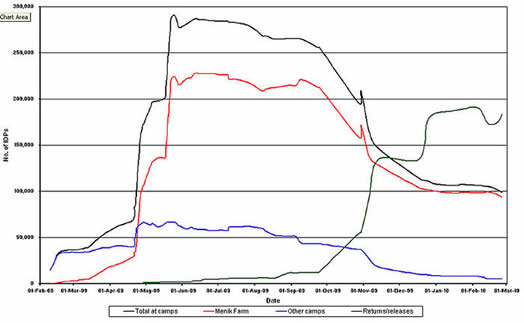Ilankai Tamil Sangam30th Year on the Web Association of Tamils of Sri Lanka in the USA |
|||
 Home Home Archives Archives |
The Refugees and ResettledLanka’s Nowhere Peopleby Suthirtho Patranobis, Hindustan Times, March 18, 2010
In Zone II, tattered UN tents helplessly flap against the strong breeze as red dust swirls up like a thousand tiny tornadoes. Inside the 16 feet by six feet tents where a dozen would stay, the heat takes your breath away; outside, the temperature and dust makes it difficult to breathe. UN and government officials admit that the shelf-life of the IDP tents is long over though they still shelter about 20,000 displaced Tamils in Zone II. But it’s unlikely that their tents would be replaced. From December, the government’s focus has shifted from displacement to “resettlement” of those released from the camps. “Distribution of ration has become irregular and hygiene kits are no longer available. Many of the (communal) toilets cannot be used anymore,’’ a public health inspector, said. “In Menik Farm (Vavuniya)… funding shortages will affect humanitarian operations starting the end of February. This includes, among others, complementary food distribution, water bowsering, toilet maintenance and healthcare provision,’’ an UN report recently said. The remaining IDPs are, however, putting their heads down and living their hard lives in the hope of getting released from the camps, soon. But how different is the life of a ‘resettled’ IDP? HT met few resettled families in Kilinochchi last week. They have been given Rs 5,000 (Sri Lankan) in cash and promised another Rs 20,000 and some basic provisions like tarpaulin sheets and cooking utensils. A weekly ration of rice, flour and sugar is given as well. The families of Kanikarasa and Kamaladevi were standing on the rubble of their former homes in Kilinochchi. “Our homes were destroyed in the fighting. We have to rebuild from scratch. But first, I have to look for a job,’’ a family head said. Nearby, S Silvadasan and his two neighbours of 22 years were tightening the poles of their three adjoining tents — where there homes once were. “There is nothing left. But we are happy to be out of the camps,’’ he said. On the stretch of the A9 highway between Vavuniya and Jaffna, hundreds of released IDP families have put up flimsy tents or taken shelter in broken houses. After months in camps, they now have the freedom of movement. But little else. In government statistics, these families have been resettled. In reality, it will take years for their uprooted lives to be anchored. |
||
|
|||
 A scorching March heat is sweeping the Menik Farm camps for the internally displaced persons (IDPs).
A scorching March heat is sweeping the Menik Farm camps for the internally displaced persons (IDPs).